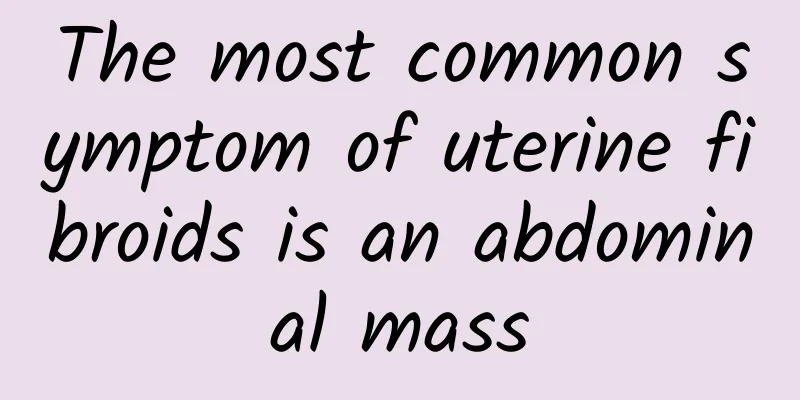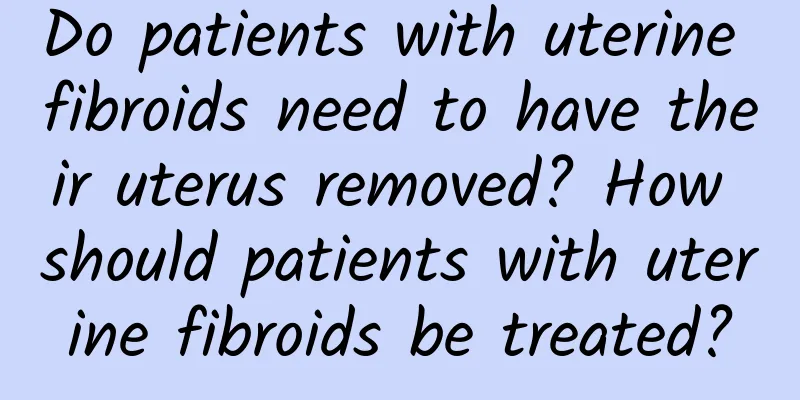The most common symptom of uterine fibroids is an abdominal mass

|
The most common symptom of uterine fibroids is abdominal mass, and people can usually find the disease after touching this symptom. So do you know what the symptoms of uterine fibroids are? This is a question that people ask a lot, and the following authoritative experts will explain it to you in detail. The main symptoms of uterine fibroids are as follows: 1. Abdominal mass: Patients feel abdominal lumps themselves, mostly after uterine fibroids grow out of the pelvic cavity. It is often obvious in the early morning when the bladder is full on an empty stomach. It is one of the common symptoms of uterine fibroids. Because the uterus and fibroids are pushed upward, it is easy for patients to touch them themselves. If the uterus is larger than 4 to 5 months of pregnancy, it can also be touched when the bladder is not full. Uterine fibroids are generally located in the middle of the lower abdomen, and a few may be located on one side of the lower abdomen. They are hard or have an uneven feeling. Larger ones are more likely to be degenerated, softer and smoother. Most grow slowly. A very small number may grow faster or be accompanied by dull pain, and malignant changes should be suspected. 2. Pain: The symptoms of this type of uterine fibroids are that the tumor compresses the pelvic blood vessels, causing congestion, or compresses the nerves, or the pedicled submucosal fibroids can stimulate uterine contraction, which is discharged from the uterine cavity to the outside, causing the cervical canal to widen and cause pain; or the necrosis and infection of the fibroids cause pelvic inflammatory disease, adhesions, traction, etc. If some individuals have red degeneration of uterine fibroids, the abdominal pain is more severe and accompanied by fever. Acute and severe abdominal pain also occurs when the pedicle of the uterine subserosal fibroids is torsion or the axial torsion of the uterus. Large subserosal fibroids grow into the broad ligament, which can not only compress the nerves and blood vessels to cause pain, but also compress the ureters to cause ureteral or renal hydrops and cause low back pain. Those with severe and progressive dysmenorrhea are often caused by uterine fibroids complicated by adenomyosis or endometriosis. This is also a common symptom of uterine fibroids. 3. Uterine bleeding: Symptoms of this type of uterine fibroids occur in half or more of the patients. Most of them are excessive menstrual flow, prolonged menstruation or shortened menstrual cycle, accounting for about 2/3; persistent or irregular bleeding accounts for 1/3, which are also common symptoms of uterine fibroids. Bleeding is mainly caused by intramural fibroids and submucosal fibroids. Intramural fibroids often have periodic bleeding, while submucosal fibroids often show irregular bleeding. Subserosal fibroids rarely cause uterine bleeding, and in some cases, the menstrual flow is reduced. The above is the explanation given by experts on the symptoms of uterine fibroids. Experts remind that if you cannot distinguish the type of disease, the best way is to go to the hospital for examination. Do not take medicine at random according to your own will, which will worsen the condition or cause other diseases. |
<<: Ectopic pregnancy may be caused by maldevelopment of the fallopian tube
>>: Cervical erosion may also cause some bladder symptoms
Recommend
What is adenomyosis?
What is adenomyosis? What is it? 1. Adenomyosis i...
Is motherwort granules or capsules better? The efficacy is basically the same
The main ingredients of Motherwort Granules and M...
"Iron Legs" went downstairs in shock! 3 tips to relieve muscle soreness
Summer is here and more people are exercising. Ho...
Can congenital absence of vagina be treated?
When congenital absence of vagina occurs in femal...
Is menopause amenorrhea?
Women will enter menopause at around 45 years old...
Why do patients with recurrent miscarriage need immunological examination?
It is not uncommon for women to have three or mor...
What are the symptoms of cervicitis?
Summer is the peak season for female cervicitis. ...
How to solve morbid obesity? Gastric reduction surgery successfully reduces weight
Mr. Chen, 57 years old, likes to eat sweets and s...
Diagnosis and treatment of patients with congenital absence of vagina
What is the diagnosis and treatment of patients w...
Fallopian tube disease can cause ectopic pregnancy
The causes of ectopic pregnancy are relatively co...
How to care after childbirth
Nowadays, there are many young female friends who...
A slim figure is not a dream! 3 keys to lose weight easily
Everyone knows that exercise is the most effectiv...
What examinations do patients with cervicitis need to take? Daily precautions for women with cervicitis
Cervicitis is an internal vaginal disease. It is ...
The magic weapon for lowering blood lipids, "okra water", is very popular! 3 easy steps to DIY, effectively relieve diabetes and joint pain
Drinking a cup of "okra water" every da...
How is vulvar itching transmitted?
If you want to treat vulvar itching, you must und...









